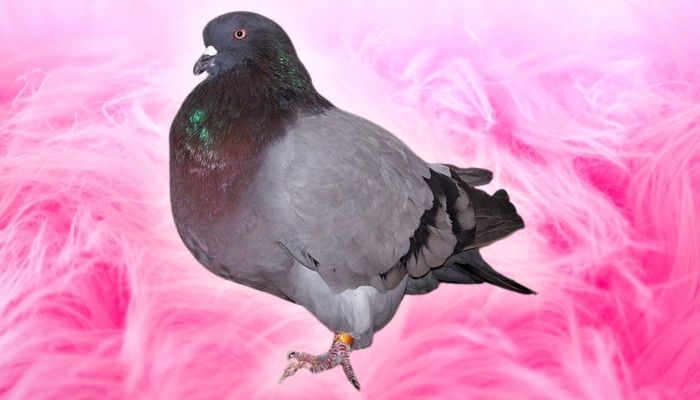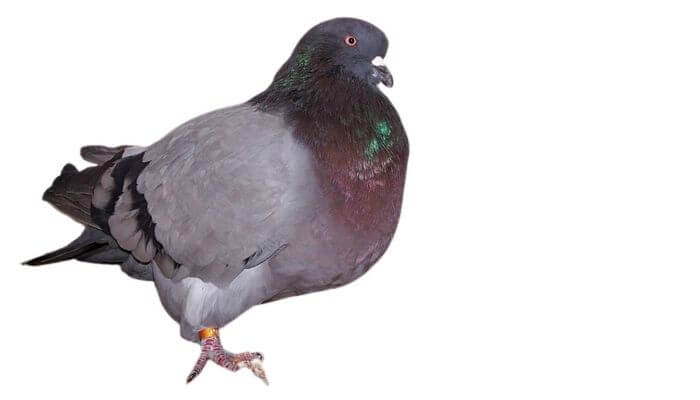The Giant Runt pigeon is a common type of pigeon that today is mostly associated with the USA.
More than anything, the Giant Runt breed is known for its very large size when compared to other breeds, as well as its suitability for squab production.

Though the word ‘runt’ often comes with negative connotations in the animal world, the origin of the term stems back to France and Spain where the word meant ‘plain’ or ‘common’.
It’s important to note that runt in this context does refer to any kind of malfunction or disability in this particular bird
Giant Runt Pigeon Origins
The American Giant Runt is one of the largest and oldest domestic pigeon breeds, and its reputation for great squab production is something that sets it apart from others of its species.
The Giant Runt began as an ancient pigeon breed that was thought to have existed back in Ancient Roman times.
When in the first century AD Pliny the Elder referred to a very large breed of pigeon in Campagna, he was describing the Giant Runt.
As the image of the pigeon is included in the carvings on the interior columns of St. Peter’s Basilica in Rome, it can be assumed the Giant Runt was very common in Italy.
It is also known that giant pigeons were bred in Spain and southern France where the Giant Runt was known as the Roman Pigeon.
It is not known exactly when the original Giant Runt arrived in the USA although evidence shows that in 1873, the bird featured in an exhibition in Philadelphia as recorded by author of “The Pigeon”, Wendell Levi.
American breeders wanted to accentuate the Giant Runt’s defining characteristics so cross-bred it with other pigeon varieties to produce a bird that was wider but more compact giving more power and greater body mass.
The broader bird naturally has more meat and primarily, this was a key reason behind the generation of this bigger breed.
Today, squab meat is less popular although some breeders do produce Giant Runts for food purposes.
Today’s American Giant Runt is regal and gentle.
Giant Runt Pigeon Appearance
The signature physical characteristics of a Giant Runt pigeon are its wide-body and dense mass, but as with most pigeon breeds there are standards by which they are judged, and these standards (according to the Giant Runt Club of America) are also the key characteristics in the appearance of the bird.

- BODY: A Giant Runt should be stout with a rounded chest and broad shoulders but not fat. They should be as large as possible but still look neat and trim. Their average weight is between 1 and 1.2 kgs but prime examples can weigh 1.3 to 1.4 kg.
- HEAD: The Giant Runt has a large, broad head that carries boldness and strength. The top of the pigeon’s skull isn’t flat or round like some others, but rather oval. The back of the skull is well developed which gives a long head.
- BEAK: The beak is broad (a trademark across the body with the Giant Runt!), and fairly thick. Color-wise, it is black with a hint of blue.
- WATTLE: The wattle is small, oval and finely textured.
- EYE CERE: Neat and not too coarse. In all colours of Giant Runts it is red, except in Blue Runts where the cere is plum or damson in colour.
- EYES: Giant Runt’s eyes are bright and clear to display their good health. They are pearl-coloured in all varieties apart from whites which has bull-coloured eyes.
- NECK: The pigeon’s neck is medium in length, free from gullet and appears full and broad towards the breast! The feathers are generally full enough to provide a proud and dense display.
- WINGS: Wings are of a moderate length with a width that is proportional to the size of the pigeon. They are folded close to the body and wrap over the rump as the pigeon is flying.
- BACK: A very long back with broad shoulders that appears straight when viewed from the side. Wing feathers should be thick and long.
- TAIL: The tail should be wedge-shaped with the same width as the bird’s body and it should follow the sweep of the back. It shouldn’t drag on the floor when the pigeon walks.
- COLOR: The original Runt was fairly neutral in colour, but modern Giants can range through blue, silver, black, yellow, dun, white, red and grizzle.
Character of the Giant Runt Pigeon
If you are interested in taking ownership of a Giant Runt Pigeon then you need to be aware of its character and personality to make sure that the traits are something you are looking for and can cope with.
Due to their exaggerated size, Giant Runts are not great flyers.
They will happily fly to perches and lower targets, but long-distance flying is not something that a Giant Runt enjoys or is capable of.
Just like any other breed, it is hard to determine the exact personality of the Giant Runt as each individual pigeon can be different from the next.
In general, however, it has been noted that many runt pigeons do not love being petted, held or even touched on certain occasions.
They are comfortable around humans but prefer to maintain a little distance.
As with all types of birds, the younger they are when you start interacting with them, the more comfortable they will be with your handling.
Hand raised Giant Runt pigeons are much more likely to have no fear of you at all.
Breeding Giant Runts
Breeding Giant Runt pigeons, just like the breeding of any other type of bird, comes with its own specific challenges.
Of course, the older the pigeon is, the more hit and miss the production of fertile eggs becomes. In terms of this particular breed, old age is termed to be anything over five years.
A good diet is necessary for encouraging fertility, as well as allowing the birds to have access to plenty of invigorating sunlight.
If you assess your pigeons and feel that their feathers are too thick in certain important breeding areas, then one solution could be trimming the area around the vent to allow for better contact between the birds.
Giant runts are not great parents as they are rather clumsy and can easily destroy freshly laid eggs by stepping on them.
How Do You Take Care of a Giant Runt Pigeon
The care needed for a Giant Runt pigeon is the same kind of basic care needed for any other type of pigeon. Here are some of the most important care tips:
- The larger the cage, the better. An outdoor coop or specifically designed loft are the two most suitable options depending on where you live and what your climate is like. It is possible to buy a suitable home but if you build your own pigeon coop it will have the specific dimensions you require.
- Make sure that your space is high and spacious enough for the pigeons to have sufficient room for short flight hops, as well as being prepared to let them fly around properly outside for around two hours of exercise per day.
- An easy way to ensure they receive a balanced healthy diet is to use one of the many commercial bird feeds that are designed with the appropriate nutrients. Avoid seed only diets, as they don’t have sufficient calcium content.
- Good hygiene is essential, both for the pigeon and the pigeon’s home environment. Make sure that you clean the cage or loft daily, as well providing a fresh batch of floor covering and new water.
The Giant Runt Pigeon is one of the most visually striking birds of its kind, thanks to its large size and broad appearance. Now that you know more about this special breed, maybe you can think about owning one or two of them in the future.
